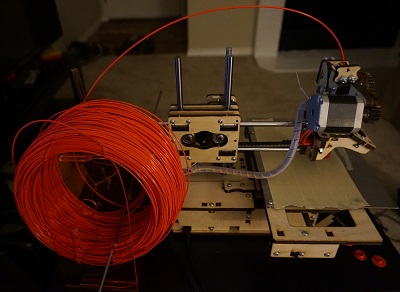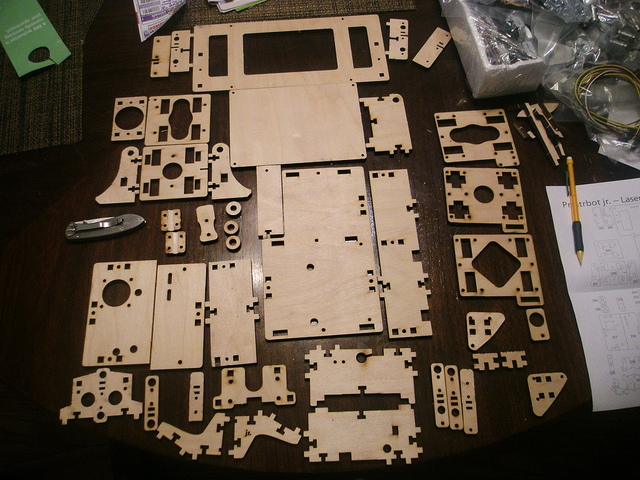HardwareProjects - About the Printrbot Jr
July 2013
Hardware

For experimentation purposes, I bought a Printrbot JR 3D printer when the wooden model was still being sold (v1).
Since then, I've been able to fine-tune the printer to reliably print with 0.3 mm layer heights and sometimes print at 0.1 mm.
Over the past years I've performed minor updates, mainly replacing the printbed (first to acrylic (which melted), then to 4130 steel), and updating the firmware.
Since then, I've been able to fine-tune the printer to reliably print with 0.3 mm layer heights and sometimes print at 0.1 mm.
Over the past years I've performed minor updates, mainly replacing the printbed (first to acrylic (which melted), then to 4130 steel), and updating the firmware.
I have since upgraded to a newer printer, but even with this older printer I was able to reliably print with it due to knowing the limitations and strengths of this design.

Software
To reliably print with this printer, I have used the following settings:
| Parameter | Setting | Units |
|---|---|---|
| Heater Temp | 196-200 | OC |
| Perimeter Speed | 60 | mm/s |
| Small Perimeter Speed | 60 | mm/s |
| Infill Speed | 80 | mm/s |
| Support Speed | 90 | mm/s |
| Bridges Speed | 90 | mm/s |
| Gap Speed | 30 | mm/s |
| Travel Speed | 130 | mm/s |
However, those settings are only applicable when using either Repetier-Host
or Matter Control to load up the STL file, Slic3r to slice the file
into layers, and either program to send the slices to the 3D printer for printing.
To actually design the models to 3D print, I either use an existing model on Thingiverse or design my own.
Designing a 3D model can be done with a variety of software:
- Autodesk Inventor: Sketch-and-constraint based 3D modeling software. Expensive for both personal and professional use, but I used this software in high-school design courses.
- Blender: Subdivision freeform modeling tool. Has an immense learning curve and is very focused towards the arts, making it harder to design objects to dimentions.
- BRL-CAD: A CSG-based modeling tool, with extensive functionality. I used this for a few models before moving onto other software.
- OpenSCAD: A CSG modeling tool designed heavily for programmers and those who need to script objects. It is slow but useful enough that I've used this for a good number of my 3D printing projects.
- Solidworks: Sketch-and-constraint based 3D modeling software. Expensive for both personal and professional use, but I used this software throughout university.
- Wings3D: A subdivision modeling tool like Blender, but with a much easier to use UI. However, just like Blender, it is not focused for engineering designs. I have used this tool sparingly.
At the end of the day, the software isn't what makes a good design. A good design comes from a good idea and the commitment of time to implement it, along
with the tooling to express the design effectively. One great example of this is the Printrbot's laser-cut parts -- there are many parts, but
they all work together to allow you to make more parts of your own design.
